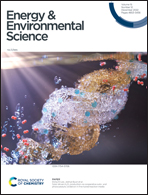Polarity and moisture induced trans-grain-boundaries 2D/3D coupling structure for flexible perovskite solar cells with high mechanical reliability and efficiency†
Abstract
To commercialize flexible perovskite solar cells (f-PSCs), they must achieve mechanical reliability along with high power conversion efficiency (PCE) and long-term stability. 2D/3D stacking of perovskites can theoretically improve the photovoltaic performance and mechanical reliability of f-PSCs simultaneously. But due to the complexity of the surface reaction, it remains a significant challenge to precisely control the growth of 2D perovskites with favorable growth sites, morphologies, and mechanical properties on 3D perovskites. Here we report the polarity of X-bromobenzylamine (X = 2, 3, and 4) salts as well as ambient moisture to be critical factors governing the reaction selectivity and growth behavior of 2D perovskites on 3D perovskites. The mild polarity-induced reaction selectivity, namely 4-bromobenzylamine cations with PbI2, enables precise growth of 2D perovskites at the grain boundaries (GBs) of 3D perovskites, while moderate moisture further stimulates the growth of 2D perovskites to form a trans-GBs structure. This unique “trans-GBs” 2D perovskite forms a p–n heterojunction with 3D perovskites, enhancing the built-in potential and exhibiting an excellent passivation effect and suitable mechanical properties (with the Young's modulus comparable to that of 3D MHP). As a result, the trans-GBs 2D/3D based f-PSCs obtained a certified PCE of up to 22.1% and maintained ∼80% of their initial PCE after 8000 bending cycles (R = 4 mm).



 Please wait while we load your content...
Please wait while we load your content...